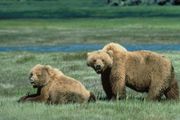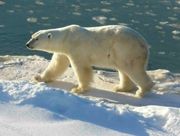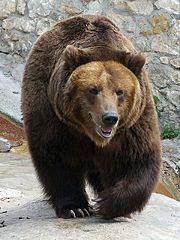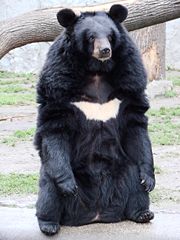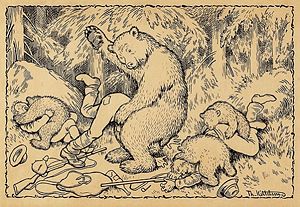Bear
2008/9 Schools Wikipedia Selection. Related subjects: Mammals
| Bear Fossil range: Late Eocene - Recent |
||||||||||||||
|---|---|---|---|---|---|---|---|---|---|---|---|---|---|---|
 Brown bear at the Pyrenees Animal Park.
|
||||||||||||||
| Scientific classification | ||||||||||||||
|
||||||||||||||
| Genera | ||||||||||||||
Bears ( family Ursidae) are mammals in the order Carnivora. Bears are classified as caniforms, or doglike carnivorans, with the pinnipeds being their closest living relatives. Although there are only eight living species of bear, they are widespread, appearing in a wide variety of habitats throughout the Northern Hemisphere and partially in the Southern Hemisphere. That which pertains to bears is called ursine. Bears are found in the continents of North America, South America, Europe, and Asia.
Common characteristics of modern bears include a large body with stocky legs, a long snout, shaggy hair, plantigrade paws with five nonretractile claws, and a short tail. While the polar bear is mostly carnivorous and the giant panda feeds almost entirely on bamboo, the remaining six species are omnivorous, with largely varied diets including both plants and animals.
With the exceptions of courting individuals and mothers with their young, bears are typically solitary animals. They are sometimes diurnal, but are usually active during the night ( nocturnal) or twilight ( crepuscular). Bears are aided by an excellent sense of smell, and despite their heavy build and awkward gait, they can run quickly and are adept climbers and swimmers. Bears use shelters such as caves and burrows as their dens, which are occupied by most species during the winter for a long period of sleep similar to hibernation.
Bears have been hunted since prehistoric times for their meat and fur. To this day, they play a prominent role in the arts, mythology, and other cultural aspects of various human societies. In modern times, the bear's existence has been pressured through the encroachment of their habitats and the illegal trade of bears and bear parts, including the Asian bile bear market. The IUCN lists six bear species as vulnerable or endangered, and even " least concern" species such as the brown bear are at risk of extirpation in certain countries. The poaching and international trade of these most threatened populations is prohibited, but still ongoing.
Biology
Reproduction
The bear's courtship period is very brief. Bears in northern climates reproduce seasonally, usually after a period of inactivity similar to hibernation, although tropical species breed all year round. Cubs are born toothless, blind, and bald. The cubs of brown bears, usually born in litters of 1–3, will typically stay with the mother for two full seasons. They feed on their mother's milk through the duration of their relationship with their mother, although as the cubs continue to grow, nursing becomes less frequent and learn to begin hunting with the mother. They will remain with the mother for approximately three years, until she enters the next cycle of estrus and drives the cubs off. Bears will reach sexual maturity in five to seven years.
Dentition
Unlike most other members of the Carnivora, bears have relatively undeveloped carnassial teeth, and their teeth are adapted for a diet that includes a significant amount of vegetable matter. The canine teeth are large, and the molar teeth flat and crushing. There is considerable variation in dental formula even within a given species. It has been suggested that this indicates bears are still in the process of evolving from a carnivorous to a predominantly herbivorous diet. Polar bears appear to have secondarily re-evolved fully functional carnassials, as their diet has switched back towards carnivory. The dental formula for living bears is:
| 3.1.2-4.2 |
| 3.1.2-4.3 |
Winter dormancy
Many bears of northern regions are assumed to hibernate in the winter. While many bear species do go into a physiological state called hibernation or winter sleep, it is not true hibernation. In true hibernators, body temperatures drop to near ambient and heart rate slows drastically, but the animals periodically rouse themselves to urinate or defecate and to eat from stored food. The body temperature of bears, on the other hand, drops only a few degrees from normal and heart rate slows only slightly. They normally do not wake during this "hibernation", and therefore do not eat, drink, urinate or defecate the entire period. Higher body heat and being easily roused may be adaptations, because females give birth to their cubs during this winter sleep. It can therefore be considered a more efficient form of hibernation because they need not awake through the entire period, but they are more quickly and easily awakened at the end of their hibernation. They have to stay in a den for the whole hibernation.
Relationship with humans
Some species, such as the polar bear, American black bear, and the grizzly bear, are dangerous to humans, especially in areas where they have become used to people. On the west coast of Canada, the American black bear has become an integral part of the silviculture industries, specifically treeplanting. The bears are coaxed into areas of harvested forest to "flush out" the other wildlife, i.e. moose, which are a far greater threat to planters. For the most part, bears are shy and are easily frightened of humans. They will, however, defend their cubs ferociously if a situation calls for it.
Laws have been passed in many areas of the world to protect bears from hunters or habitat destruction. Bears in captivity have been trained to dance, box, or ride bicycles; however, this use of the animals became controversial in the late 20th century.
Bears as food and medicine
Many people enjoy hunting bears and eating them. Their meat is dark and stringy, like a tough cut of beef. In Cantonese cuisine, bear paws are considered a delicacy. The peoples of China, Japan, and Korea use bears' body parts and secretions (notably their gallbladders and bile) as part of traditional Chinese medicine. It is believed more than 12,000 bile bears are kept on farms, farmed for their bile, in China, Vietnam and South Korea. Bear meat must be cooked thoroughly as it can often be infected with trichinellosis.
Classification
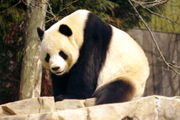
- Family Ursidae
- Subfamily Ailuropodinae
- Giant Panda, Ailuropoda melanoleuca
- Dwarf Panda, Ailuropoda minor†
- Subfamily Tremarctinae
- Spectacled Bear, Tremarctos ornatus
- Florida Cave Bear, Tremarctos floridanus†
- Giant Short-faced Bear, Arctodus simus†
- Unnamed short-faced bear species, Arctodus pristinus†
- Brazilian Short-faced Bear, Arctotherium brasilense†
- Argentine Short-faced Bear, Arctotherium latidens†
- Subfamily Ursinae
- Brown Bear, Ursus (Ursus) arctos
- Subspecies Syrian (Brown) Bear Ursus arctos syriacus
- Subspecies Grizzly Bear, Ursus arctos horribilis
- Subspecies Kodiak Bear, Ursus arctos middendorffi
- Subspecies Himalayan Brown Bear and Himalayan Red Bear, Ursus arctos isabellinus
- Subspecies Himalayan Blue Bear, Ursus arctos pruinosus
- Subspecies Bergman's Bear, Ursus arctos piscator†?
- Gobi bear, Ursus arctos gobiensis (very rare)
- Atlas Bear, Ursus arctos crowtheri†
- American Black Bear, Ursus (Ursus) americanus
- Subspecies Cinnamon Bear, Ursus americanus cinnamomum
- Subspecies Kermode Bear, Ursus americanus kermodie
- Polar Bear, Ursus maritimus
- Asiatic Black Bear, Ursus thibetanus
- Formosan Black Bear, Ursus thibetanus formosanus
- Ursus thibetanus gedrosianus
- Ursus thibetanus japonica
- Ursus thibetanus laniger
- Ursus thibetanus mupinensis
- Ursus thibetanus thibetanus
- Ursus thibetanus ussuricu
- Sloth Bear, Melursus ursinus
- Subspecies Sri Lankan Sloth Bear Melursus ursinus inornatus
- Subspecies Indian Sloth Bear Melursus ursinus ursinus
- Sun Bear, Helarctos malayanus
- Subspecies Borneo Sun Bear Helarctos malayanus euryspilus
- Auvergne Bear, Ursus minimus†
- Etruscan Bear, Ursus etruscus†
- European Cave Bear, Ursus spelaeus†
- MacFarlane's Bear, Ursus (Vetularctos) inopinatus ( cryptid; if an authentic species, extinct)
- Brown Bear, Ursus (Ursus) arctos
- Subfamily Ailuropodinae
The genera Melursus and Helarctos are sometimes also included in Ursus. The Asiatic black bear and the polar bear used to be placed in their own genera, Selenarctos and Thalarctos which are now placed at subgenus rank.
A number of hybrids have been bred between American black, brown, and polar bears (see Ursid hybrids).
Evolutionary relationships
The Ursidae family belongs to the order Carnivora and is one of nine families in the suborder Caniformia, or "doglike" carnivorans. Bears' closest living relatives are the pinnipeds, a clade of three families: Odobenidae (the walrus), Otariidae (fur seals and sea lions), and Phocidae (true or earless seals). Bears comprise eight species in three subfamilies: Ailuropodinae (monotypic with the giant panda), Tremarctinae (monotypic with the Spectacled Bear), and Ursinae (containing six species divided into one to three genera, depending upon authority).
The origins of Ursidae can be traced back to the very small and graceful Parictis that had a skull only 7 cm (3 in) long. Parictis first occur in North America in the Late Eocene (ca. 38 million years ago), but this genus did not appear in Eurasia and Africa until the Miocene. The raccoon-sized, dog-like Cephalogale, however, is widely regarded as the most primitive ursid and is ideally suited as a representative basal taxon for the family. Cephalogale first appeared during the middle Oligocene and early Miocene (approximately 20–30 million years ago) in Europe. Cephalogale gave rise to a lineage of early bears of the genus Ursavus. This genus radiated in Asia and ultimately gave rise to the first true bears (genus Ursus) in Europe, 5 million years ago. Even among its primitive species, such as C. minor, it exhibits typical ursid synapomorphic dentition such as posteriorly oriented M2 postprotocrista molars, elongated m2 molars, and a reduction of the premolars. Living members of the ursids are morphologically well defined by their hypocarnivorous (non-strictly meat-eating) dentitions, but fossil ursids include hypercarnivorous (strictly meat-eating) taxa, although they never achieved the extreme hypercarnivory seen in mustelids. Cephalogale was a mesocarnivore (intermediate meat-eater). Other extinct bear genera include Arctodus, Agriarctos, Plionarctos and Indarctos.
It is uncertain whether ursids were in Asia during the late Eocene, although there is some suggestion that a limited immigration from Asia may have produced Parictis in North America due to the major sea level lowstand at ca. 37 Ma, but no Parictis fossils have yet to be found in East Asia. Ursids did, however, become very diversified in Asia later during the Oligocene. Four genera representing two subfamilies (Amphicynodontinae and Hemicyoninae) have been discovered in the Oligocene of Asia: Amphicticeps, Amphicynodon, Pachycynodon, and Cephalogale. Amphicticeps is endemic from Asia and the other three genera are common to both Asia and Europe. This indicates migration of ursids between Asia and Europe during the Oligocene and migration of several taxa from Asia to North America likely occurred later during the late Oligocene or early Miocene. Although Amphicticeps is morphologically closely related to Allocyon, and also to Kolponomos of North America, no single genus of the Ursidae is known to be common to both Eurasia and North America. Cephalogale, however, do appear in North America in the early Miocene. It is interesting to note that rodents, such as Haplomys and Pseudotheridomys (late Oligocene) and Plesiosminthus and Palaeocastor (early Miocene), are common to both Asia and North America and this indicates that faunal exchange did occur between Asia and North America during the late Oligocene to early Miocene. Ursid migration from Asia to North America would therefore have also been very likely to occur during this time. Three major carnivoran migrations between Eurasia and North America are recognized in the late Neogene that definitely included ursids. The first around 20 Ma (probably 21–18 Ma) were waves of intermittent dispersals that included Amphicynodon, Cephalogale and Ursavus. The second migration occurred at about 7–8 Ma and included Agriotherium. And the last wave took place in the early Pliocene 4 Ma with Ursus.
The giant panda's taxonomy has long been debated. Its original classification by Armand David in 1869 was within the bear genus Ursus, but in 1870 it was reclassified by Alphonse Milne-Edwards to the raccoon family. In recent studies, the majority of DNA analyses suggest that the giant panda has a much closer relationship to other bears and should be considered a member of the family Ursidae. The status of the red panda remains uncertain, but many experts, including Wilson and Reeder, classify it as a member of the bear family. Others place it with the raccoons in Procyonidae or in its own family, the Ailuridae. Multiple similarities between the two pandas, including the presence of false thumbs, are thought to represent convergent evolution for feeding primarily on bamboo.
There is also evidence that, unlike their neighbors elsewhere, the brown bears of Alaska's ABC islands are more closely related to polar bears than they are to other brown bears in the world. Researchers Gerald Shields and Sandra Talbot of the University of Alaska Fairbanks Institute of Arctic Biology studied the DNA of several samples of the species and found that their DNA is different from that of other brown bears. The researchers discovered that their DNA was unique compared to brown bears anywhere else in the world. The discovery has shown that while all other brown bears share a brown bear as their closest relative, those of Alaska's ABC Islands differ and share their closest relation with the polar bear. There is also supposed to be a very rare large bear in China called the blue bear, which presumably is a type of black bear. This animal has never been photographed.
Koalas are often referred to as bears due to their appearance; they are not bears, however, but marsupials.
Culture
Myth and legend
Some evidence has been brought to light on prehistoric bear worship, see Arctic, Arcturus, Great Bear, Berserker, Kalevala. Anthropologists such as Joseph Campbell have regarded this as a common feature in most of the fishing and hunting-tribes. The prehistoric Finns, along with most Finno-Ugric peoples, considered the bear as the spirit of one's forefathers. This is why the bear was a greatly respected animal, with several euphemistic names.
This kind of attitude is reflected in the traditional Russian fairy tale " Morozko", whose arrogant protagonist Ivan tries to kill a mother bear and her cubs — and is punished and humbled by having his own head turned magically into a bear's head and being subsequently shunned by human society.
There has been evidence about early bear worship in China and among the Ainu culture as well. In the Korean mythology, Korean people identifies bear as their ancestor and symbolic animal.
In addition, the Proto-Indo-European word for bear, *hr̥ktos (ancestral to the Greek arktos, Latin ursus, Welsh arth (cf. Arthur), Sanskrit *ṛkṣa, Hittite hartagga) seems to have been subject to taboo deformation or replacement (as was the word for wolf, wlkwos), resulting in the use of numerous unrelated words with meanings like "brown one" (English bruin) and "honey-eater" (Slavic medved). Thus four separate Indo-European language groups do not share the same PIE root. The theory of the bear taboo is taught to almost all beginning students of Indo-European and historical linguistics; the putative original PIE word for bear is itself descriptive, because a cognate word in Sanskrit is rakshas, meaning "harm, injury".

In the arms of the bishopric of Freising (illustration, right) the bear is the dangerous totem animal tamed by St. Corbinian and made to carry his civilised baggage over the mountains: the allegory of the civilising influence of Christianity is inescapable. A bear also features prominently in the legend of St. Romedius, who is also said to have tamed one of these animals and had the same bear carry him from his hermitage in the mountains to the city of Trento.
Imaginary bears are a popular feature of many children's stories including Goldilocks and the Three Bears, the Berenstein Bears, and Winnie the Pooh.
The constellations Ursa Major and Ursa Minor represent bears.
Symbolic use
The bear is a common National personification for Russia (as well as the Soviet Union) and even Germany. The brown bear is Finland's national animal. In the United States, the black bear is the state animal of Louisiana, New Mexico, and West Virginia; the grizzly bear is the state animal of both Montana and California.
Also, "bear", " bruin", or specific types of bears are popular nicknames or mascots, e.g. for sports teams ( Chicago Bears, Boston Bruins); and a bear cub was mascot of the 1980 Summer Olympics in Moscow, USSR.
Smokey Bear has become a part of American culture since his introduction in 1944. Known to almost all Americans, he and his message, "Only You Can Prevent Forest Fires" (updated in 2001 to "Only You Can Prevent Wildfires") has been a symbol of preserving woodlands. Smokey wears a hat similar to one worn by many U.S. state police officers, giving rise to the CB slang "bear" or "Smokey" for the highway patrol.
Figures of speech
The physical attributes and behaviours of bears are commonly used in figures of speech in English. In the stock market, a bear market is a period of declining prices. Pessimistic forecasting or negative activity is said to be bearish (due to the stereotypical posture of bears looking downwards), and one who expresses bearish sentiment is a bear. Its opposite is a bull market, and bullish sentiment from bulls. In gay slang, the term " bear" refers to male individuals who possess physical attributes much like a bear, such as a heavy build, abundant body hair, and commonly facial hair. To "try like a bear" means to try your hardest to catch the attention of a certain lady. The harder you try, the better the bear you are. A bear hug is typically a tight hug that involves wrapping one's arms around another person, often leaving that person's arms immobile. It was used in the Ronald Reagan political ad "Bear in the woods."
- "Bear tracking"
In the old Western states of the U.S. and to this day in the former Dakota Territory, the expression, "You ain't just a bear trackin'.", is used to mean "You ain't lying." or "That's for sure." or "You're not just blowing smoke." This expression evolved as an outgrowth of the experience pioneer hunters and mountainmen had when tracking bear. Bears often lay down false tracks and are notorious for doubling back on anything tracking them. If you are not following bear tracks, you are not following false trails or leads in your thoughts, words or deeds.
Teddy bears
Around the world many children have stuffed animals in the form of bears.
Names
In Scandinavia the word for bear is Björn (or Bjørn), and is a relatively common given name for males. The use of this name is ancient and has been found mentioned in several runestone inscriptions. The name was also used by J.R.R. Tolkien in his book "The Hobbit", where a bear-like character is named Beorn.
The female first name "Ursula", originally derived from a Christian saint's name and common in English- and German-speaking countries, means "Little she-bear" (dimunitive of Latin "ursa"). In Switzerland the male first name "Urs" is especially popular.
In Russian and other Slavic languages, the word for bear, " Medved" (медведь), and variants or derivatives such as Medvedev are common surnames.
In East European Jewish communities, the name "Ber" (בער) — Yiddish cognate of "Bear" — has been attested as a common male first name, at least since the 18th century, and was among others the name of several prominent Rabbis. The Yiddish "Ber" is still in use among Orthodox Jewish communities in Israel, the US and other countries.
With the transition from Yiddish to Hebrew under the influence of Zionism, the Hebrew word for "bear", "Dov" (דב), was taken up in contemporary Israel and is at present among the commonly used male first names in that country.
